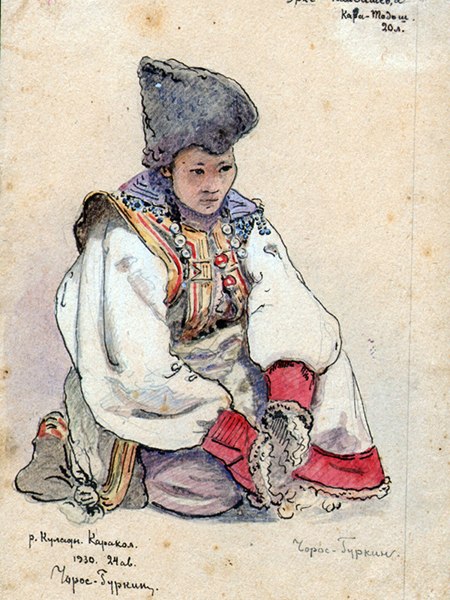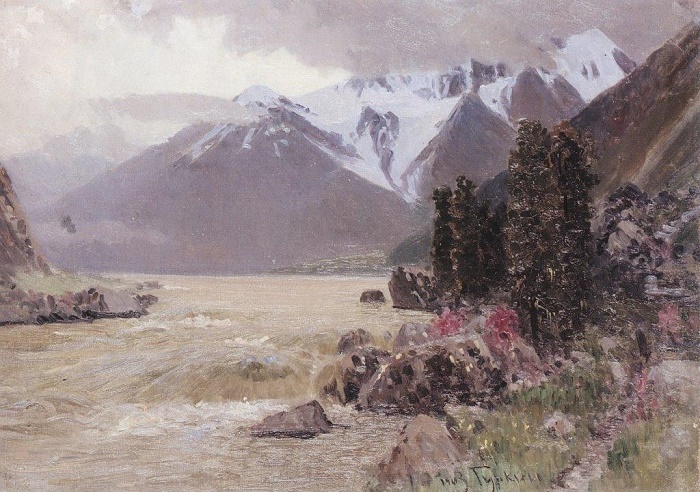Soviet Russian artist Grigory Ivanovich Gurkin 1870-1937

Altayka (Altay woman) in Chegedek, 1911. Oil on canvas. Painting by Soviet Russian artist Grigory Ivanovich Gurkin (12 January 1870 – 11 October 1937)
Soviet Russian artist Grigory Ivanovich Gurkin
Born in 1870 in the village of Ulala (now Gorno-Altaisk), Grigory Gurkin was an Altai artist, a student of Ivan Shishkin. By origin he was Altaian, a descendant of Telenget khan Konnay. Aged 8, Gurkin attended the icon-painting class of the Altai spiritual mission school. After graduating from the missionary school, he worked as a teacher for a while, but soon turned to icon painting. In 1896 Gurkin got acquainted with the collector of Altai folklore, AV Anokhin, who discovered the world of contemporary painting to a young artist.
The first picture, with which he tried to get to the Academy (“Night of the victim”), full of mystery and naivety. Orthodox by birth and education, the artist very vaguely depicted the life and religion of the Altaians. Only later, during the creative dawn, the author became seriously engaged in the study of the Altai way of life. Noteworthy, he left thousands of drawings, which also have an ethnographic value.

Detail of first painting ‘Night of the victim Kamlanie’. 1895. Oil on canvas. Soviet Russian artist Grigory Ivanovich Gurkin (12 January 1870 – 11 October 1937)
Shortly he studied in the workshop of I. I. Shishkin, who died suddenly, working at the easel before Gurkin’s eyes. Also, he studied in the workshop of AA Kiselev, in the Academy. There, the master opened his true vocation – the landscape. However, after a period of imitation of Shishkin, the artist found his own way. Already during 1903-1905 he created a series of paintings characterizing a mature master.
Meanwhile, in 1903, the artist returned to the Altai, settled in Anos (near the famous nowadays resort of Chemal), began working as a teacher and married a Russian woman.
During 1906-1915 the artist traveled all over Siberia with exhibitions and became a recognized classic of Siberian painting.

Fern at the pond. 1911
An important period of Gurkin’s life and work (1917-1937) became the events of the revolution, the Civil War and the establishment of Soviet power in Siberia. In 1917, on the wave of revolution, the state formation of Altaians (Karakorum-Altai District Council) took place, and the artist, as the most famous representative of the indigenous nationality, was persuaded to lead it.
Unfortunately, in April 1919 the Kolchakites arrested the unfortunate leader “for separatism and treason” sent him to the prison of the city of Biysk. Released on bail, the artist, hid his paintings, and with his family hurried to Mongolia, and in 1920 he moved to Tuva.
Soviet Russian artist Grigory Ivanovich Gurkin

Altai woman in a red scarf. 1932
However, in 1925, the authorities persuaded the artist to return to Soviet Russia. Initially, the reception of Grigory Gurkin was enthusiastic, the artist received possibility to exhibit his works. Thus, he had two exhibitions of Soviet Art in Novosibirsk, and in 1926 – in Moscow. Noteworthy, even Lunacharsky added his own voice to the chorus of raptures.

Hunters in the Altai mountains. Oil on canvas
In fact, the creative path of the artist in the 1920s and 1930s, closely connected with the socialist Altai, was in demand in the Soviet Union. Indeed, no holiday in the Altai Mountains, and even in Novosibirsk, was not without the artist’s participation. Posters, drawings and other work of the day become the artist’s responsibility. Also, he created drawings for the Altai alphabet, illustrated the folk epic, and continued to draw pictures. Meanwhile, his painting has acquired new qualities – they became colorful and peaceful. Besides, decorative work played an ever greater role in his work.
Tragically, in 1937, Soviet Russian artist Grigory Ivanovich Gurkin got arrested and shot on charges of “organizing an underground nationalist group and espionage in favor of Japan”.
Rehabilitated posthumously in 1956.

Anosinsk woods. 1903. Oil on canvas

Forest landscape

In the upper Anos. 1921. Oil on canvas

Kezer Tash. 1912. Oil, canvas. (Stone women, ancient sculpture)

Khan Altay. 1916. Oil on canvas

Lake in Lazha

The Karakol (lake)

The Taimenie

Boulders

Landscape with eagles. 1936

Monument to G. I. Gurkin. Opened July 5, 2006 in in the center of Gorno-Altaysk, work of sculptor V. Kukuyev

Mountain Gorge. 1900. Oil, canvas

Night of the victim Kamlanie. 1895. Oil o

Oil painting Nomads in the mountains. 1920. Oil on canvas

Nomads in the mountains. 1920

Portrait of Altay type

Portrait of Erke Kaibasheva

Road in the forest. 1897. Oil, canvas

Shaman’s grave. Oil on canvas

Soviet Russian artist Grigory Ivanovich Gurkin (12 January 1870 – 11 October 1937)

Spirit of mountains

The altar. 1909. Oil, canvas

The Belukha. 1926. Oil, canvas

The bridge over Malagas. 1908

The Chamal

The crown of the Katun. 1910. Oil on canvas

The Glacier Gebler – The Origins Of The Katun. 1899

The Katun in spring. 1911. Oil on canvas

The lake of mountain spirits. 1910

The Katun river. 1906. Oil on canvas

The river Kuyum. 1911

The Surroundings Of Ulala

The Teletskoye lake

The view of the Katyn in spring. 1903. Oil on canvas

The view on the Belukha. 1926. Oil on canvas

The village of Anos

The Yurt in the garden of the artist

Waterfall Katu-Yaryk. oil on canvas

Waterfall on the Balyk-Suu. 1912. Oil on canvas





